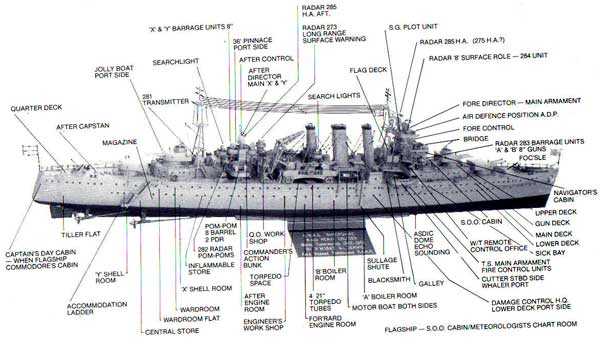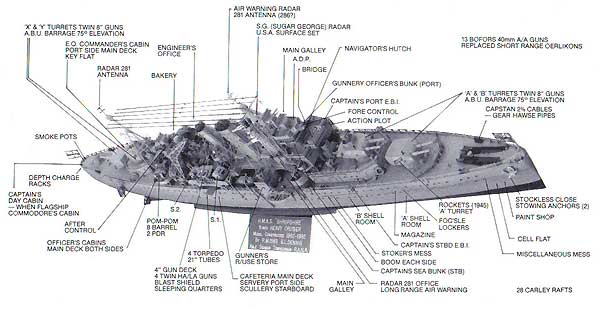HMAS Canberra.
I served in HMAS Canberra as a Sub Lieutenant RAN from December 1941 until she was sunk at the Battle of Savo Island on the 9th. of August 1942. At the commencement of that Battle I was the Officer of the Watch on her bridge.
Canberra's Radar Officer, David Medley.
About May of 1942, as part of a refit in Sydney, Canberra, was I believe, the first RAN ship to be fitted with Radar. She had the British Type 271 radar set fitted, and Sub Lieutenant David Medley RANVR both fitted this set, and became the ship's radar officer. I must say it was still considered a Black Art by senior officers.
Although we had picked up the US destroyer Blue on patrol on the seaward side of Savo Island at a distance of 30 miles previously, with misty weather on the night of August 8/9, we certainly did not detect by our radar 271, the approaching Japanese surface force. But then neither did Blue nor Ralph Talbot on picket duty, either see the Japanese visually, or pick them up on their radar.
David Medley, post war went off to live in the United States and became a naturalised US citizen, and still lives there. In 2004 we corresponded, and he had this to say about the radar fitted in Canberra.
" I have never forgotten the short time I served on Canberra and have been haunted throughout the years about what I could or should have done to make the more senior officers aware of the capabilities of the radar equipment on board. 20/20 hindsight is always misleading and I constantly remind myself that in those days an RANVR Sub Lieutenant, wet behind the ears, was regarded as the lowest form of animal life.and not to be taken seriously. I doubt that Capt Getting even knew that I existed. He certainly never exhibited the slightest interest in the radar installations.
"I noted with interest that you served in Shropshire. I wonder sometimes why I was not given the opportunity to join Shropshire, but I don't believe that subject ever arose. Although the court of inquiry absolved me from any blame I guess some stigma may have stuck to me.
"I was never sent to sea again except on short cruises involved with my work in developing new radar for the navy which was what I was better fitted for anyway.
"You and Bruce Loxton are the only members of the Canberra gunroom that I remember clearly. I suspect that this is because you were the only two people that were interested enough to ask about the radar installations."
HMAS Shropshire.
I served in HMAS Shropshire as a Lieutenant RAN from December 1944 to mid 1946, she had a wonderful ship's company and was a happy and lucky ship. The fact that we did not lose a man to enemy action was, I believe, largely due to her radar equipment fitted, and the great radar operators who manned them.
Our Task Force Admiral would signal to ships in company " Pay attention to Porthole's Radar reports, SHE IS HOT STUFF! "
The ship's radar sets fitted.

Drawing of Shropshire showing her Radar sets various Aerials positions.
Type 281. AIR WARNING. 90 megacycles frequency.
Transmitting antenna fitted on mainmast and the transmitter was in the office at the vase of this mast. The receiving antenna fitted on the foremast, and its receiving office fitted on the flag deck at the foremast's base. The antennae rotated in synchronism.
Aircraft reports on planes went off to the Air Defence Office manned by radar rates with Lieutenant Ron. Major in charge, here both enemy and friendly aircraft were plotted, and this office was in touch with ships in the Fleet by voice signal.
The ship's famous call sign "PORTHOLE" was often on the air, and we were well known for the quality of our radar warnings of enemy aircraft. In perfect weather conditions, Able Seaman Joe Barringtom MID, who could read round the curved edge of the radar screen could report the enemy as far away as 120 miles.
Type 273. SURFACE WARNING. 10cm wavelength. 3,000 megacycles frequency.
Antenna which was gyrostablised was in a lantern type structure on top of its office in turn located just forward of the after control. This set connected to an accurate range display panel in the transmitting station.
Type 274. MAIN ARMANENT.
Antenna mounted on the main armanent director located above the bridge, just forward of the foremast. its office was below decks, and range and bearing for the main 8 inch gun armament was supplied to a display panel in the main transmitting station.

Second Drawing showing Shropshire radar set Aerials positions.
4 Type 283 sets. AUTO BARRAGE UNITS.
There was one of these sets for each of the four 8 inch gun turrets, and each had a control station with a display unit on the upper deck. The main office for these units below decks. The objective of the 283 sets was to enable efficient use of the main armament against dive bombing attaks, and they proved useful against the Kamikazes.
Each of these sets had a small fire control device like a mechanical computer.
The main armament guns could be loaded with shells fitted with a timefuse, generally set for a different time in each gun barrel, the FC Device would work out the correct time, and fire the guns so that when the shell exploded, it was at the same place as the aircraft would be if it flew on at the same course and speed.
Type 285. 4 inch ANTI AIRCRAFT GUNS.
Antenna mounted on the Aft High Angle Control Director. Its office was below decks. Function to mprovide range and beariung fot the 4 inch AA fire control.
Type 285. MULTIPLE POM POMS.
One set to control each of the port and starboard Pom Pom mountings.
TYPE SG. SURFACE WARNING. 10cm wave length.
An American set, fitted after joining the 7th. Fleet. Antenna fitted on foremast with its PPI display in the Plotting Office below the bridge, used for both navigation and surface warning.
Type 277. AIRCRAFT TRACKING. 10cm wave length.
This unit was fitted during a mid year refit in 1945. Antenna was fitted on the foremast, and its office was in a special extension built on the port side of the bridge structure. Its single dish antenna controlled for both bearing and elevation, and this equipment gave the exact location of its target,
As it turned out the war was almost over, we had the Borneo landings to come, and then the dropping of the two Atomic bombs hastened the end, Japan surrendered, and at last it was all over.
GUNNERY CONTROL.
The gunnery control radar sets were combined in an integrated system, they all operated at the same frequency, about 600 megacycles. Power came from a large motor-generator with a 500 cycle 180 volt output, to avoid interference there was a phase difference between the poser supplied to each set.
Type 91 JAMMING TRANSMITTER.
Radar Counter Measures were fitted in Shropshire and consisted of multi band receivers and a Type 91 jamming transmitter.
NOTES.
I am beholden for the technical information to Lieutenant ( P ) R. Slayter RANVR, who supplied it to the Cruisers Association.
The two drawings of the ship showing her radar aerials etc are taken from Stan Nicholl's book: HMAS Shropshire. The Naval Historical Society of Australia. Sydney, 1989.


